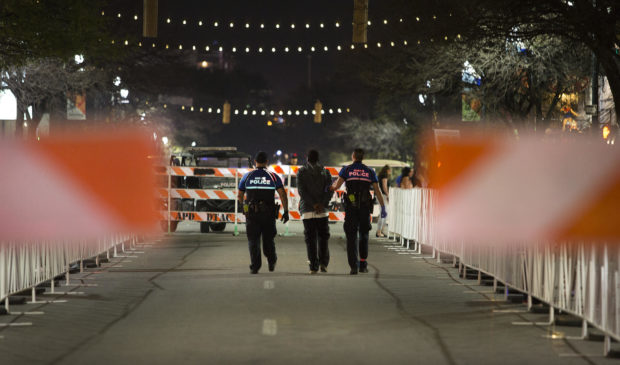From ‘Starbucks’ lines to ‘full-scale riot’: How cops and clubs control crowds during SXSW
Friday, March 16, 2018 by
Nathan Bernier, KUT The influx of 300,000 to 400,000 people to downtown Austin during South by Southwest requires an extraordinary amount of crowd control, both for event organizers and first responders.
Austin’s Police Department uses a Special Response Team to patrol downtown.
“It’s just a group of 120 officers who are trained and responsible for crowd management,” APD Assistant Chief Justin Newsom said at a briefing before the festival. “Everybody on that team is trained, and it’s organized and equipped to handle everything from just a large crowd milling about to a full-scale riot.”
Promoters and club managers use their own techniques to manage crowds, including venue design: layout, signs and obstacles to direct where people can and cannot go.
“Imagine that a fire were to start in the middle of this venue. How much differently would you be looking at this situation?” Ritual Events owner Max Gregor asked on a Tuesday afternoon while a team set up a venue space at Urban Outfitters on the Drag. “Your focus would go to that fire, and your focus might go to finding the quickest way out of here.”
Gregor, who used to produce the Fun Fun Fun Fest in Austin, said such worst-case scenarios require easy-to-navigate environments because communicating with large crowds is difficult.
When free alcohol is involved, as it is at so many SXSW events, the stakes are even higher.
“There’s usually control put in place,” Gregor said, “things like ticketing systems or limits and also just cutting things off at a reasonable hour. I think really practical measures need to be taken, because I think we’ve all … heard of the events where that isn’t factored in and it turns into complete insanity.”
Search “SXSW riot” on YouTube to find videos of some of the more famous incidents of crowds getting out of control during Austin’s spring festival season. Even though they were not open-bar situations, they were learning experiences for event organizers and the city.
At the Mohawk nightclub on Red River Street, General Manager Cody Cowan has dealt with alcohol-consuming showgoers for more than 10 years.
“I’m a dad; I’ve got a 10-year-old son. So, in some ways, I see it not much different than raising kids,” Cowan said. “You love them. You want them to have the best in life, but you also know that they’re going to wreck everything if you don’t have good boundaries and you’re not watching out for them.
“But, you know, just like with kids, you can’t be like a crazy person and threatening and do all sorts of crazy things. You have to be reasonable.
“One of my strategies in my two decades’ career is just using tone and body language and being calm. If I get uptight and all wound up, then you’re going to get all wound up.”
Cowan says he came up in the Austin music industry a couple decades ago when violence was more common at shows. He worked at Emo’s for 10 years in its original location on Sixth Street.
“Working at Emo’s, it was just like oppositional defiance. Everyone’s just like, ‘F you.’ Every person in and out is just confrontation, confrontation, confrontation,” he said. “That was pretty rough and tumble.”
He says he has noticed the behavior of music fans improve since then.
“They’re like Starbucks patrons. They just line up. They get in their lines at the door. They get in their lines at the bar,” Cowan said. “They’re just very neat and orderly, and I guess it makes life easy.”
After 21 years of working SXSW, he said every year the crowds get “chiller and chiller.”
“You just want to save anything you got for when there’s actual emergencies, just like the parenting metaphor,” he said.
“It’s like, ‘Do we need an ambulance or a cop? No? OK, everything’s cool. We’re going to be OK.’”
This story was produced as part of the Austin Monitor’s reporting partnership with KUT. Photo by Montinique Monroe/ KUT.
The Austin Monitor’s work is made possible by donations from the community. Though our reporting covers donors from time to time, we are careful to keep business and editorial efforts separate while maintaining transparency. A complete list of donors is available here, and our code of ethics is explained here.
You're a community leader
And we’re honored you look to us for serious, in-depth news. You know a strong community needs local and dedicated watchdog reporting. We’re here for you and that won’t change. Now will you take the powerful next step and support our nonprofit news organization?










